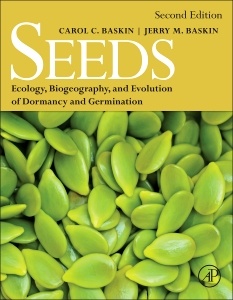Seeds (2nd Ed.) Ecology, Biogeography, and, Evolution of Dormancy and Germination
Auteurs : Baskin Carol C., Baskin Jerry M.

The new edition of Seeds contains new information on many topics discussed in the first edition, such as fruit/seed heteromorphism, breaking of physical dormancy and effects of inbreeding depression on germination. New topics have been added to each chapter, including dichotomous keys to types of seeds and kinds of dormancy; a hierarchical dormancy classification system; role of seed banks in restoration of plant communities; and seed germination in relation to parental effects, pollen competition, local adaption, climate change and karrikinolide in smoke from burning plants.
The database for the world biogeography of seed dormancy has been expanded from 3,580 to about 13,600 species. New insights are presented on seed dormancy and germination ecology of species with specialized life cycles or habitat requirements such as orchids, parasitic, aquatics and halophytes. Information from various fields of science has been combined with seed dormancy data to increase our understanding of the evolutionary/phylogenetic origins and relationships of the various kinds of seed dormancy (and nondormancy) and the conditions under which each may have evolved. This comprehensive synthesis of information on the ecology, biogeography and evolution of seeds provides a thorough overview of whole-seed biology that will facilitate and help focus research efforts.
Seeds: Ecology, biogeography, and evolution of dormancy and germination
Second Edition
Carol C. Baskin and Jerry M. Baskin
Chapter 1. Introduction
Chapter 2. Ecologically Meaningful Germination Studies
Chapter 3. Types of Seeds and Kinds of Seed Dormancy
Chapter 4. Germination Ecology of Seeds with Nondeep Physiological Dormancy
Chapter 5. Germination Ecology of Seeds with Morphophysiological Dormancy
Chapter 6. Germination Ecology of Seeds with Physical Dormancy
Chapter 7. Germination Ecology of Seeds in the Persistent Seed Bank
Chapter 8. Variation in Seed Dormancy, Germination and Size Within and Between Individuals and Populations of a Species
Chapter 9. A Geographical Perspective on Germination Ecology: Tropical and Subtropical Zones
Chapter 10. A Geographical Perspective on Germination Ecology: Temperate and Arctic Zones
Chapter 11. Germination Ecology of Plants with Specialized Life Cycles and/or Habitats
Chapter 12. Biogeographical and Evolutionary Aspects of Seed Dormancy
References
Subject Index
Taxonomic Index
She has written several publications on the subject of seed germination, most notably Seeds: Ecology, biogeography, and evolution of dormancy (Elsevier), in collaboration with her husband Dr Jerry M. Baskin.
Dr Baskin received his Ph.D. from Vanderbilt University in June 1967 and after 1 year of postdoctoral work at the University of Florida joined the University of Kentucky (UK) Biology faculty in 1968. He was promoted to Full Professor in 1981and retired from UK in June 2011. Almost all of his publications are co-authored with Carol C. Baskin. He has approximately 520 journal articles plus 14 book chapters and 10 publications in symposium and conference proceedings. The first edition of “Seeds was published in 1998 and the second edition in 2014. The book on rock outcrops and barrens (co-edited with J. Fralish and R. Anderson) was published in 1999.
- Most wide-ranging and thorough account of whole-seed dormancy available
- Contains information on dormancy and germination of more than 14,000 species from all the continents – even the two angiosperm species native to the Antarctica continent
- Includes a taxonomic index so researchers can quickly find information on their study organism(s) and
- Provides a dichotomous key for the kinds of seed dormancy
- Topics range from fossil evidence of seed dormancy to molecular biology of seed dormancy
- Much attention is given to the evolution of kinds of seed dormancy
- Includes chapters on the basics of how to do seed dormancy studies; on special groups of plants, for example orchids, parasites, aquatics, halophytes; and one chapter devoted to soil seed banks
- Contains a revised, up-dated classification scheme of seed dormancy, including a formula for each kind of dormancy
- Detailed attention is given to physiological dormancy, the most common kind of dormancy on earth
Date de parution : 04-2014
Ouvrage de 1600 p.
21.5x27.6 cm



